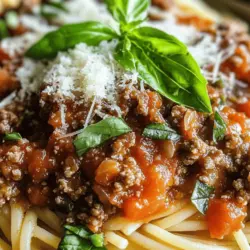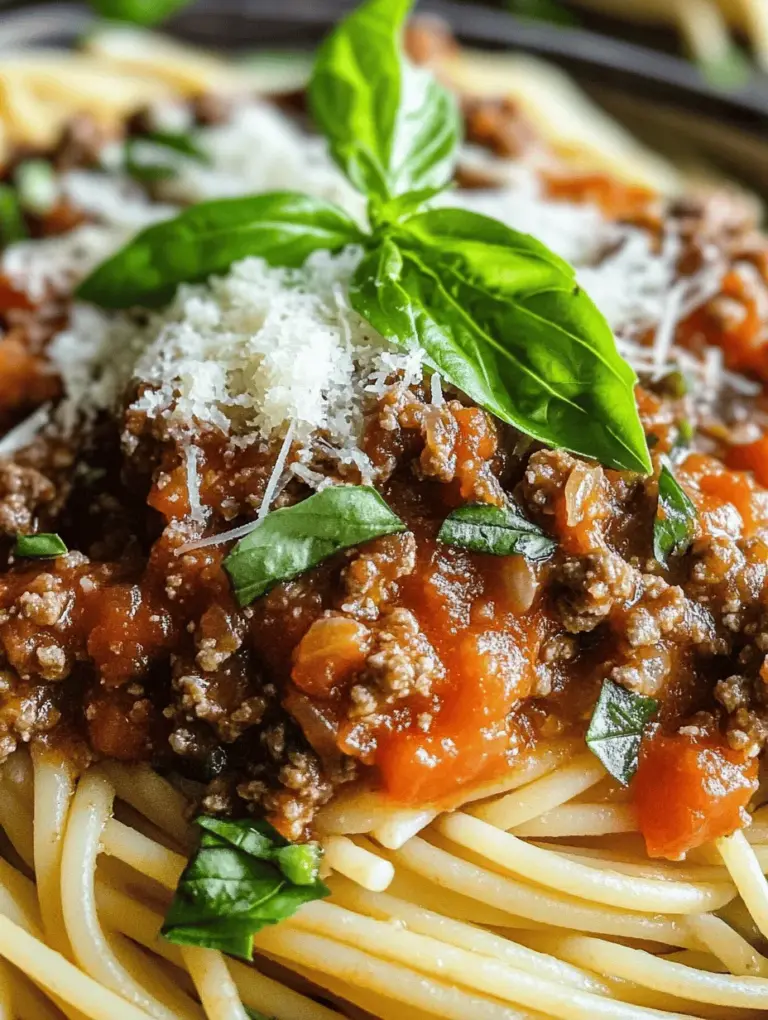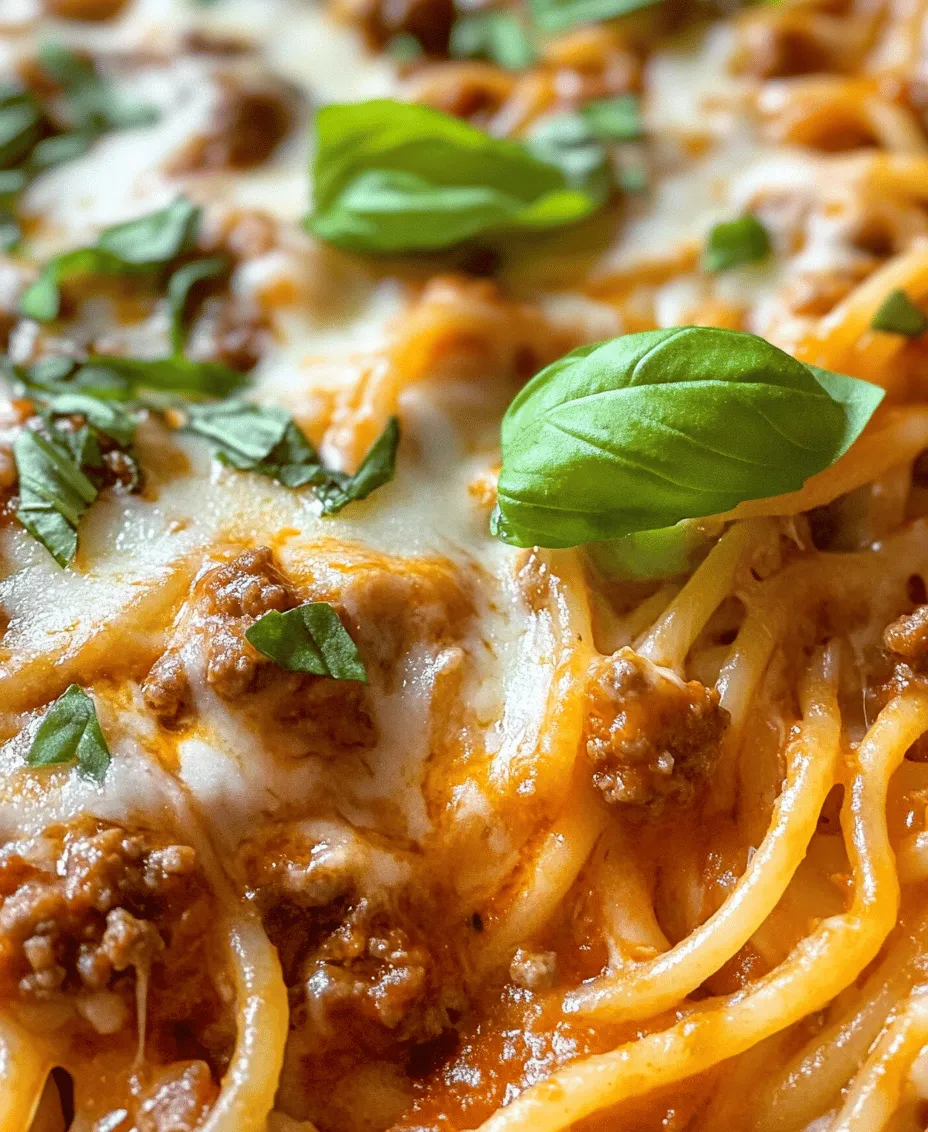Introduction
Bolognese spaghetti is more than just a meal; it is a heartwarming experience that embodies the spirit of Italian cuisine. This beloved dish, known for its rich and savory meat sauce, has become a staple in kitchens around the world. Its allure lies not only in its delicious taste but also in the way it brings people together, making it a popular choice for family dinners and gatherings. Whether you are a seasoned chef or a novice cook, the process of preparing Bolognese spaghetti offers an opportunity to indulge in the joy of cooking while creating a dish that is both satisfying and comforting.
What truly sets Bolognese spaghetti apart is the emphasis on authentic ingredients and traditional cooking techniques. The richness of the sauce is a result of carefully selected ingredients, slow-cooked to develop deep flavors. While many variations of Bolognese sauce exist, adhering to authentic practices will elevate your dish and provide a taste of Italy right in your home. From the choice of meats to the inclusion of fresh herbs, every element plays a crucial role in crafting an unforgettable meal.
The History of Bolognese Sauce
The origins of Bolognese sauce can be traced back to the city of Bologna, Italy. Known as “ragù alla Bolognese,” this sauce was first documented in the late 18th century, though its roots likely extend even further back. Historically, it was a dish that represented the agricultural richness of the region, utilizing local ingredients from the fertile lands surrounding Bologna. Over the years, the sauce has evolved, with various interpretations emerging across Italy and beyond.
Cultural significance is woven into the fabric of Italian cuisine, and Bolognese sauce is no exception. It reflects the Italian tradition of slow cooking and the importance placed on family meals. In many Italian households, preparing ragù is a communal affair, often involving multiple generations coming together to share recipes, stories, and laughter. This cultural heritage continues to influence how Bolognese spaghetti is enjoyed today.
As you travel through Italy, you will find regional variations of the classic Bolognese sauce. In some areas, you might encounter recipes that incorporate pancetta or use different types of meat, while others might include a variety of vegetables. Each version tells a story of its own, showcasing the local ingredients and culinary practices that define the region. Despite these variations, the core essence of Bolognese sauce remains—rich, hearty, and deeply satisfying.
Understanding the Ingredients
To create the perfect Bolognese spaghetti, understanding the key ingredients and their roles in the dish is essential. Each component contributes to the overall flavor profile and texture, making the dish a delightful experience for the palate.
High-Quality Olive Oil and Fresh Vegetables
The foundation of any good sauce starts with quality ingredients, and Bolognese is no different. High-quality extra virgin olive oil is vital for sautéing your base vegetables, as it not only adds flavor but also provides healthy fats that enhance the overall richness of the dish. Fresh vegetables, such as onions, carrots, and celery, form the classic soffritto, which is the aromatic base of the sauce. The combination of these ingredients adds depth and sweetness, creating a balanced flavor.
Meat Choices: Ground Beef versus a Mix of Beef and Pork
When it comes to the meat, traditional recipes often call for a mix of ground beef and pork. This combination provides a balance of flavor and fat content, resulting in a sauce that is both hearty and succulent. Ground beef alone can also work well, but the addition of pork adds a layer of complexity that enhances the overall taste. Whichever option you choose, it is crucial to select high-quality meats to achieve the best results.
The Role of Wine
Wine is an essential ingredient in Bolognese sauce, acting as a flavor enhancer that brings out the richness of the meat and vegetables. A good dry red wine, such as Chianti or Sangiovese, is often recommended. As the sauce simmers, the alcohol cooks off, leaving behind a depth of flavor that elevates the dish. The acidity of the wine also helps to tenderize the meat, making it melt-in-your-mouth delicious.
Herbs and Spices for Authentic Taste
For an authentic Bolognese flavor, traditional Italian herbs such as bay leaves, thyme, and parsley are essential. These herbs infuse the sauce with fragrant notes that harmonize beautifully with the other ingredients. Additionally, a touch of nutmeg adds warmth and complexity, making your sauce truly stand out.
Dairy: Milk or Cream
While not all recipes include dairy, adding a splash of milk or cream toward the end of cooking is a common technique used to achieve a creaminess that rounds out the flavors. The milk helps to soften the acidity of the tomatoes, creating a well-balanced sauce that is less robust but incredibly smooth.
Step-by-Step Guide to Making Bolognese Spaghetti
Now that we have an understanding of the key ingredients, let’s dive into the step-by-step process of making Bolognese spaghetti. This guide will ensure you achieve a deliciously authentic dish that captures the essence of Italy.
Preparing the Spaghetti: Achieving the Perfect Al Dente Texture
The first step in your Bolognese spaghetti journey is preparing the pasta. For the best results, always opt for high-quality dried spaghetti and follow these tips to achieve that perfect al dente texture:
1. Use Plenty of Water: Fill a large pot with water, allowing enough space for the pasta to move freely. A general rule of thumb is to use 4-6 quarts of water for every pound of pasta.
2. Salt the Water Generously: Once the water is boiling, add a generous amount of salt. This is your only chance to season the pasta itself, so don’t hold back. Aim for a saltiness comparable to the sea.
3. Cook Time: Refer to the package instructions for the cooking time, but start checking the pasta a couple of minutes before the suggested time. For al dente, the pasta should be tender but firm to the bite.
4. Reserve Pasta Water: Before draining the spaghetti, remember to reserve a cup of the pasta cooking water. This starchy water can be added to your sauce later to help bind the flavors together.
Sautéing the Vegetables: Techniques for Maximizing Flavor
While the pasta cooks, it’s time to prepare your sauce by sautéing the vegetables. Follow these techniques to maximize the flavor:
1. Heat the Olive Oil: In a large, heavy-bottomed pot or Dutch oven, heat a couple of tablespoons of high-quality extra virgin olive oil over medium heat.
2. Add the Soffritto: Once the oil is shimmering, add finely chopped onions, carrots, and celery (the classic soffritto). Sauté these vegetables for about 5-7 minutes, or until they become soft and translucent. Stir occasionally to prevent them from browning too quickly.
3. Season as You Go: As the vegetables cook, season them with a pinch of salt and pepper. This step enhances their natural sweetness and builds layers of flavor right from the start.
4. Add Garlic: If you enjoy the flavor of garlic, add minced garlic to the sautéed vegetables in the last minute of cooking to avoid burning. The aroma will be irresistible.
Browning the Meat: Importance of Texture and Flavor Development
With the soffritto ready, it’s time to brown the meat, a crucial step in developing the sauce’s flavor:
1. Increase the Heat: Raise the heat to medium-high before adding your ground meat to the pot. This will help achieve a nice sear.
2. Break It Up: Add the ground beef and pork mixture to the pot, breaking it up with a wooden spoon. Spread it out evenly across the pan to ensure even browning.
3. Let It Brown: Allow the meat to cook undisturbed for a few minutes to develop a nice brown crust, then stir and continue cooking until it’s fully browned. This process adds depth and richness to your sauce.
4. Deglaze with Wine: Once the meat is browned, pour in your chosen red wine, scraping up any browned bits stuck to the bottom of the pot. This step incorporates additional flavor and helps to create a rich sauce. Allow the wine to simmer for a few minutes until it reduces slightly.
By following these initial steps, you will lay a strong foundation for your Bolognese spaghetti, ensuring a delicious and authentic Italian dish that is sure to impress family and friends alike. The careful preparation of each ingredient and technique reflects the love and passion that goes into Italian cooking, setting the stage for a culinary experience that is both fulfilling and memorable.
Incorporating Wine and Tomatoes: Balancing Flavors and Achieving Depth
To create an authentic Bolognese sauce, the incorporation of wine and tomatoes is crucial for achieving a rich and nuanced flavor profile. Begin by choosing a quality dry red wine, such as Chianti or Merlot. The wine not only adds acidity but also deepens the overall flavor of the sauce. When selecting tomatoes, opt for San Marzano tomatoes if possible, as they are renowned for their sweetness and low acidity, which complements the other ingredients beautifully.
To incorporate, add about one cup of the red wine to your sautéed vegetables after they have softened. Allow the wine to simmer for a few minutes until it reduces by half, concentrating its flavors. Then, stir in the crushed or diced tomatoes, ensuring that they fully blend with the wine and vegetables. Season with a pinch of salt and freshly ground black pepper to enhance the flavor further. The result is a robust base that sets the stage for the simmering process ahead.
Simmering the Sauce: The Importance of Patience in Flavor Development
Once the tomatoes and wine are combined with the sautéed vegetables, bring the mixture to a gentle simmer. This step is where the magic happens; patience is key. Allow the sauce to simmer uncovered for at least 45 minutes, but ideally for one to two hours. During this time, the flavors meld together, and the sauce thickens. Stir occasionally to prevent sticking, and add a splash of water if it becomes too thick.
As the sauce simmers, the aroma will fill your kitchen, inviting everyone to gather around. The slow cooking process breaks down the tomatoes and develops a complexity that cannot be rushed. Taste periodically, adjusting seasoning as necessary, which allows you to refine the flavor profile to your liking.
Finishing Touches: How Milk or Cream Enhances the Sauce and Balances Acidity
In the final stages of cooking your Bolognese sauce, the addition of milk or cream is a game changer. This step not only enhances the richness of the sauce but also helps to balance the acidity from the tomatoes and wine. Add about half a cup of whole milk or heavy cream to the sauce during the last 15 minutes of cooking. Stir well to incorporate, allowing the cream to blend seamlessly with the sauce.
This finishing touch lends a silky texture to the Bolognese, making each bite luscious. If you prefer a lighter option, using milk instead of cream will still yield a delightful result without overwhelming the dish.
Combining Spaghetti with Sauce: Techniques for Perfect Integration
Achieving the perfect integration of spaghetti and sauce is an art. Once your Bolognese sauce is ready, cook your spaghetti according to the package directions until al dente. Reserve a cup of the pasta water before draining the spaghetti, as this starchy liquid can help bind the sauce and pasta together.
In a large skillet, combine the drained spaghetti with the Bolognese sauce over medium heat. Toss gently but thoroughly, allowing the pasta to absorb the flavors of the sauce. If the sauce appears too thick, add a splash of the reserved pasta water to achieve your desired consistency. This technique ensures that each strand of spaghetti is generously coated with the flavorful sauce, making for a harmonious dish.
Serving Suggestions and Pairings
Ideal Garnishes: Fresh Basil and Parmesan Cheese
When serving your Bolognese spaghetti, presentation matters. A sprinkle of freshly chopped basil adds a burst of color and freshness, enhancing the dish’s visual appeal. For cheese lovers, don’t skimp on the freshly grated Parmesan cheese. The nutty flavor of the cheese pairs beautifully with the rich sauce, adding an extra layer of indulgence.
Recommended Side Dishes to Complement the Meal
To round out your dining experience, consider serving a light side salad dressed with a vinaigrette, which contrasts the hearty richness of the Bolognese. A simple arugula or mixed greens salad with cherry tomatoes and balsamic dressing would work beautifully. Additionally, crusty garlic bread is an excellent accompaniment, perfect for sopping up any leftover sauce.
Wine Pairings That Enhance the Dining Experience
When it comes to wine pairings, stick with red wines that match the depth of your Bolognese sauce. A medium to full-bodied red such as Chianti, Sangiovese, or Barolo will elevate the meal, providing a delightful balance to the flavors. Serve the wine at a slightly cooler temperature to ensure that its fruity notes shine through.
Suggestions for Leftovers and How to Store Them Properly
Bolognese spaghetti tends to taste even better the next day as the flavors continue to meld. To store leftovers, allow the dish to cool completely before transferring it to an airtight container. It can be kept in the refrigerator for up to three days. For longer storage, consider freezing the Bolognese sauce separately from the pasta. When reheating, add a splash of water or broth to maintain moisture and avoid drying out.
Variations on the Classic Recipe
Vegetarian and Vegan Adaptations of Bolognese Spaghetti
For those seeking a plant-based version of this classic dish, numerous adaptations exist. A vegetarian Bolognese can be made by substituting the meat with finely chopped mushrooms, lentils, or a mix of hearty vegetables like carrots, celery, and zucchini. Cook these vegetables until tender and incorporate them into the sauce as you would with the ground meat.
For a vegan adaptation, ensure that the wine and any added sauces are vegan-friendly. Replace the milk or cream with coconut milk or a cashew cream to maintain the richness of the sauce without dairy.
Exploring Different Meats and Protein Alternatives
While the traditional Bolognese uses ground beef or pork, feel free to experiment with other proteins. Ground turkey or chicken offers a leaner option while still delivering great flavor. For a more gourmet touch, consider using a mix of meats, such as beef and veal or a blend of sausage and ground beef, to add complexity.
Creative Twists: Adding Vegetables or Alternative Sauces for a Unique Flavor
To enhance the nutritional value and flavor complexity of your Bolognese, consider adding finely chopped vegetables, such as spinach, bell peppers, or even eggplant. These additions not only provide more nutrients but also contribute to a delightful texture.
For those looking to explore alternative sauces, consider a spicy arrabbiata or a creamy vodka sauce twist. While these variations stray from the classic recipe, they can be delicious and add a unique flair to your dinner table.
Nutritional Information
Breakdown of Calories and Nutritional Content per Serving
A typical serving of Bolognese spaghetti (about 1 cup of spaghetti with 1/2 cup of sauce) contains approximately 600-700 calories. This estimation can vary based on the specific ingredients and portion sizes used. Key nutritional components include:
– Protein: Essential for muscle repair and growth, primarily from the meat or protein alternative.
– Carbohydrates: The primary energy source, contributed by the spaghetti.
– Fats: The sauce contains fats from meat and any added dairy, providing flavor and satisfaction.
Discussion on the Health Benefits of Ingredients Used
Despite its indulgent nature, Bolognese spaghetti can offer health benefits when prepared mindfully. The tomatoes used in the sauce are rich in antioxidants, particularly lycopene, which is linked to numerous health benefits, including heart health. Fresh vegetables contribute dietary fiber, vitamins, and minerals, enhancing the dish’s nutritional profile.
Balancing Indulgence with Nutritious Choices
While Bolognese spaghetti is undoubtedly a comfort food, incorporating whole-grain pasta, lean meats, and plenty of vegetables can create a more balanced meal. Making small adjustments, such as using less oil or reducing cheese, can help maintain the dish’s indulgence while keeping it lighter.
Conclusion
Bolognese spaghetti is more than just a meal; it’s a timeless dish that brings warmth and joy to any table. Its rich, layered flavors and comforting textures make it a favorite across generations. By following this classic recipe, you can create an authentic Italian experience right in your kitchen, inviting family and friends to gather around for a delicious shared meal.
Cooking is a beautiful way to connect with loved ones, and there’s no better way to do so than over a plate of hearty Bolognese spaghetti. So roll up your sleeves, gather your ingredients, and embark on this culinary adventure. You may find that the process of cooking becomes as delightful as the final dish itself, creating lasting memories with each delicious bite.



